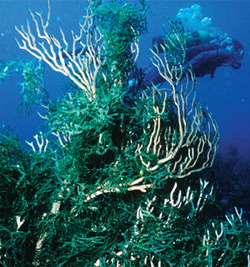Much debate and alarm have been raised about the destruction of wetlands, mangrove forests, seagrass beds and saltmarshes. These habitats are vital to the survival of coral reefs. Terrestrial waste products leach into ground water where they eventually reach the shoreline. As the water trickles past the roots and leaves of these plants, most of the waste products such as nitrates and phosphates are stripped from the water. This concept can be used to filter aquarium water as well.
Many plant filters have been created for use in freshwater aquariums. There is no single-best design for these filters, but the concept is simple. Plants are to grow either fully submerged in the sump (aquatic species) or propped up so their roots penetrate the water's surface and strip ammonia, nitrogen, phosphates and other toxins from the water. Freshwater tanks are easily filtered with a great variety of plants. Fitting a marine aquarium with a plant filter is more difficult, since relatively few plants can tolerate sea-water. There are a few plant candidates for such filters that may or may not be suited to every marine enthusiast. These filters require a lot of space and may not fit in a small fish room.
These natural filters should not be the sole means of filtration, but are worth the time to set up. The easiest way to benefit from plants is to place a handful of Caulerpa or Chaetomorpha in the sump over some live rock, give it some light and allow it to flourish. These aquatic macroalgaes rapidly if supplied with the right conditions. The faster the plants are allowed to grow, the more waste products they will remove from the water. Frequent pruning will ensure waste removal and facilitate new growth. More elaborate systems can be set up, but simplicity of maintenance is a key issue in selection. Algae turf scrubbers remove ammonia, nitrates and phosphates, but are not easy to acquire and can be difficult to maintain.
Caution should be taken with plant filters as pH and dissolved oxygen levels may be drastically altered by the addition of a mass of photosynthesizing plants. Drastic changes can be prevented with a timer to light plants only at night or when the aquariums are unlit.

No comments:
Post a Comment